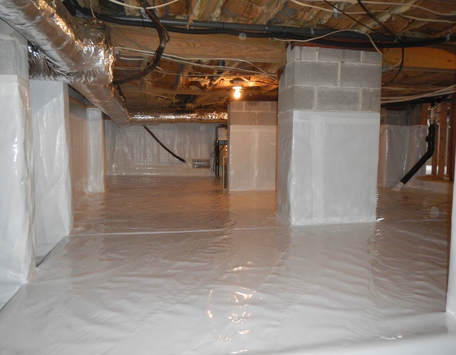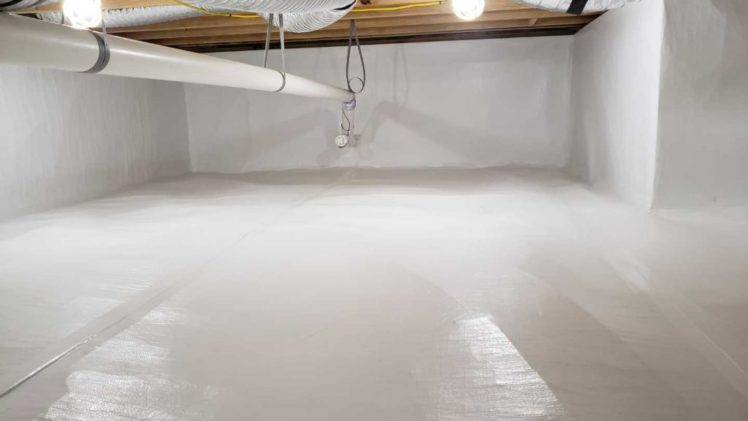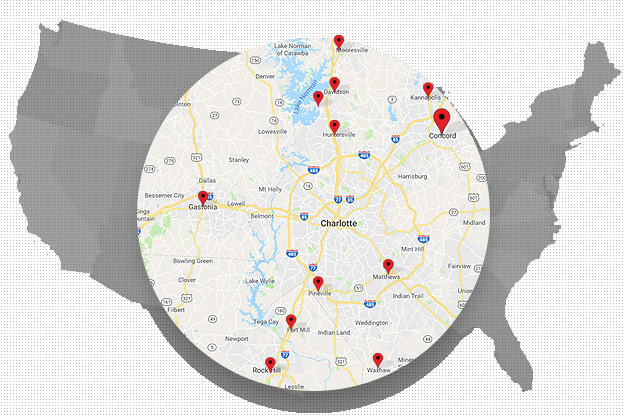Crawl Space Encapsulation
Transform Your Charlotte Home with Crawl Space Encapsulation by Sedona Waterproofing Solutions

Welcome to Sedona Waterproofing Solutions, your trusted partner in enhancing the integrity and longevity of your Charlotte home. If you’re seeking effective solutions to protect your property from moisture damage and mold growth, look no further than our expert crawl space encapsulation services.
Why Crawl Space Encapsulation Matters
Your crawl space might be out of sight, but it should never be out of mind. Neglected crawl spaces can lead to a host of issues, including moisture buildup, mold growth, pest infestations, and compromised indoor air quality. These problems not only threaten the structural integrity of your home but can also jeopardize your family’s health and well-being.
Crawl space encapsulation is the ultimate solution to safeguarding your home against these threats. By encapsulating your crawl space, you create a protective barrier that seals out moisture, prevents mold growth, and keeps pests at bay. This proactive measure not only enhances the structural integrity of your home but also improves energy efficiency and indoor air quality.
Why Choose Sedona Waterproofing Solutions
At Sedona Waterproofing Solutions, we understand the unique challenges that Charlotte homeowners face when it comes to moisture control. Our team of experienced professionals is dedicated to providing customized solutions tailored to your specific needs and budget.
When you choose us for crawl space encapsulation, you can expect:
- Expertise: With years of experience in the industry, our technicians have the knowledge and skills to deliver superior results. We utilize the latest techniques and technology to ensure that your crawl space is properly encapsulated for maximum protection.
- Quality Materials: We believe in using only the highest quality materials for all our projects. Our crawl space encapsulation products are durable, long-lasting, and designed to withstand the rigors of Charlotte’s climate.
- Attention to Detail: We take pride in our meticulous attention to detail. From thorough inspections to precise installation, we go above and beyond to ensure that every aspect of your crawl space encapsulation is completed to the highest standards.
- Customer Satisfaction: Your satisfaction is our top priority. We strive to exceed your expectations at every turn, providing responsive communication, transparent pricing, and unparalleled customer service.
 Brett StowersJune 7, 2024I had Sedona do some structural work to a water damaged band sill and joists December of 2023. Alan with Sedona was very professional and timely with all his communications and pricing. The crew onsite did a good job and completed the work in a timely manner.
Brett StowersJune 7, 2024I had Sedona do some structural work to a water damaged band sill and joists December of 2023. Alan with Sedona was very professional and timely with all his communications and pricing. The crew onsite did a good job and completed the work in a timely manner. Tia YangMay 15, 2024Well-deserved 5-star review! Absolutely incredible team from beginning to end! Quote Phase: Emily was responsive. They came out quickly and gave us a quote via email detailing the work and costs Pricing: Best prices for the work; we compared their quote apples-to-apples with 2 of their local competitors Scheduling Phase: Our work was scheduled 1 month out from the time they received payment Work Phase: The team was on top of communication throughout the whole process. Their electrician (Kevin) was late 1 day but was great with communication and very apologetic. We truly appreciate that they didn't rush to get the job done; Dan actually delayed the installation of the insulation to the crawl space because he recommended we give the products more time to dry. This, is professionalism! After Work Phase: Todd followed up with us for feedback. I told him that our humidity was high so he sent Darnell out to fix the issue the very next day. Above and Beyond: After all the work was done, I contacted Todd on a Sunday about some sitting water. He actually answered! He sent Dan out that week to talk to us about solutions and he was able to give us a quote that afternoon. Dan was extremely informative, professional and kind. Feedback to Sedona: Please allow us to make online payment at no charge or already include it in our quote **Update after 2 years** (5/15/24) Todd has been our main point of contact for our annual inspections. Todd is respectful and responsive. He provides pictures, updates and advice which really gives us a peace of mind. Thanks, Todd and Team at Sedona!
Tia YangMay 15, 2024Well-deserved 5-star review! Absolutely incredible team from beginning to end! Quote Phase: Emily was responsive. They came out quickly and gave us a quote via email detailing the work and costs Pricing: Best prices for the work; we compared their quote apples-to-apples with 2 of their local competitors Scheduling Phase: Our work was scheduled 1 month out from the time they received payment Work Phase: The team was on top of communication throughout the whole process. Their electrician (Kevin) was late 1 day but was great with communication and very apologetic. We truly appreciate that they didn't rush to get the job done; Dan actually delayed the installation of the insulation to the crawl space because he recommended we give the products more time to dry. This, is professionalism! After Work Phase: Todd followed up with us for feedback. I told him that our humidity was high so he sent Darnell out to fix the issue the very next day. Above and Beyond: After all the work was done, I contacted Todd on a Sunday about some sitting water. He actually answered! He sent Dan out that week to talk to us about solutions and he was able to give us a quote that afternoon. Dan was extremely informative, professional and kind. Feedback to Sedona: Please allow us to make online payment at no charge or already include it in our quote **Update after 2 years** (5/15/24) Todd has been our main point of contact for our annual inspections. Todd is respectful and responsive. He provides pictures, updates and advice which really gives us a peace of mind. Thanks, Todd and Team at Sedona! Shawn RamdeenApril 11, 2024Shout out to Josh, Todd, travis and Emily for helping us with our home and Waterproofing our basement on time and very reliable service could not be happier
Shawn RamdeenApril 11, 2024Shout out to Josh, Todd, travis and Emily for helping us with our home and Waterproofing our basement on time and very reliable service could not be happier Quinn AugustineMarch 25, 2024Had Sedona waterproof and drain the foundation on my new build home. Todd and Malik got the job done in one day. Fair pricing and great work.
Quinn AugustineMarch 25, 2024Had Sedona waterproof and drain the foundation on my new build home. Todd and Malik got the job done in one day. Fair pricing and great work. Todd FrasierMarch 22, 2024Outstanding service from these guys. They go above and beyond. I'm very appreciative of the work they did on my crawlspace. They are so very attentive . I'd give 10 stars if I could.
Todd FrasierMarch 22, 2024Outstanding service from these guys. They go above and beyond. I'm very appreciative of the work they did on my crawlspace. They are so very attentive . I'd give 10 stars if I could. Spencer MorphisMarch 13, 2024Enjoyed working with these guys - 10/10
Spencer MorphisMarch 13, 2024Enjoyed working with these guys - 10/10 Peter ToomeyMarch 2, 2024They did a great job with our crawlspace! I was referred by a friend, who I thanked after they finished. I would hire them again.
Peter ToomeyMarch 2, 2024They did a great job with our crawlspace! I was referred by a friend, who I thanked after they finished. I would hire them again. Cindy RatcliffJanuary 30, 2024Sedona Water Proofing was amazing. They responded quickly to our call (for help!) and within a week they were on the job. Travis and Jordan managed their team well and efficiently; they took time to answer any questions we had and thoroughly explained what the job entailed. The team worked long hours to get the job done in a timely manner for us. Travis did a final walk through with us and made sure we were comfortable and assured with the job they hade done. Would definitely recommend Sedona Water Proofing.Google rating score: 4.9 of 5, based on 142 reviews
Cindy RatcliffJanuary 30, 2024Sedona Water Proofing was amazing. They responded quickly to our call (for help!) and within a week they were on the job. Travis and Jordan managed their team well and efficiently; they took time to answer any questions we had and thoroughly explained what the job entailed. The team worked long hours to get the job done in a timely manner for us. Travis did a final walk through with us and made sure we were comfortable and assured with the job they hade done. Would definitely recommend Sedona Water Proofing.Google rating score: 4.9 of 5, based on 142 reviews
How Sedona Waterproofing can help prevent moisture problems:
01
Seal and Encapsulate your Crawl Space
We will remove the insulation from the structure’s floor joists and insulate the walls with an efficient R12 value insulation or as required by the Building Codes in your area.
Create Energy Savings Annually
Savings can range anywhere between 15% to 30% every year. In time, you can expect to recover your waterproofing expenses and then some due to the savings of an efficient modern system.
02
03
Prevent Both Mold & Moisture Problems
Crawl space encapsulation helps to prevent both mold and moisture problems. Most indoor air quality issues in homes begin in one place – the crawl space. Crawlspaces that are not encapsulated are subject to wood rot, termite and bug infestations and ruined insulation. Our team of skilled service technicians changes all of those things
Create A Clean and Healthy Environment
Our skilled staff will clean your home’s crawl space we will put down a waterproofing industry standard sealed liner on the floor and walls. We can make a transformation to the space at the completion of the project.
04
The Benefits of Crawl Space Encapsulation
Investing in crawl space encapsulation offers a multitude of benefits for Charlotte homeowners, including:
- Moisture Control: By sealing off your crawl space, you can effectively control moisture levels and prevent water damage to your home’s foundation and structural elements.
- Mold Prevention: Encapsulation creates a dry, inhospitable environment for mold growth, protecting your family from exposure to harmful mold spores.
- Improved Indoor Air Quality: By eliminating moisture and mold, crawl space encapsulation helps improve indoor air quality, reducing the risk of respiratory issues and allergies.
- Energy Efficiency: A properly encapsulated crawl space can lead to significant energy savings by reducing the workload on your HVAC system and minimizing air leakage.
- Enhanced Property Value: Crawl space encapsulation is a smart investment that can enhance the value and marketability of your home, making it more attractive to potential buyers.

Take the First Step Towards a Healthier Home
Don’t let moisture and mold compromise the safety and comfort of your Charlotte home. Take the first step towards a healthier living environment by scheduling a crawl space encapsulation consultation with Sedona Waterproofing Solutions today. With our expertise and commitment to excellence, you can trust us to protect your home for years to come.



